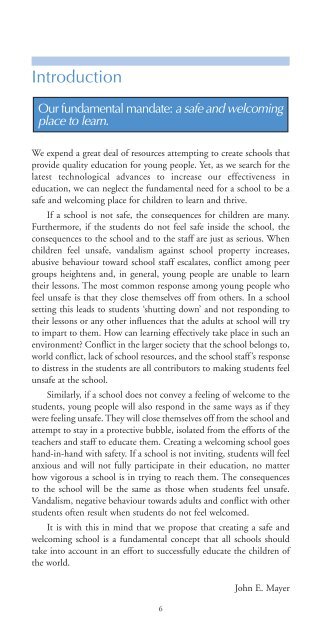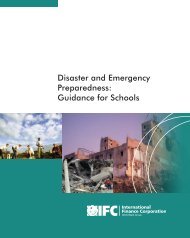Creating a safe and welcoming school - INEE Toolkit
Creating a safe and welcoming school - INEE Toolkit
Creating a safe and welcoming school - INEE Toolkit
- No tags were found...
Create successful ePaper yourself
Turn your PDF publications into a flip-book with our unique Google optimized e-Paper software.
IntroductionOur fundamental m<strong>and</strong>ate: a <strong>safe</strong> <strong>and</strong> <strong>welcoming</strong>place to learn.We expend a great deal of resources attempting to create <strong>school</strong>s thatprovide quality education for young people. Yet, as we search for thelatest technological advances to increase our effectiveness ineducation, we can neglect the fundamental need for a <strong>school</strong> to be a<strong>safe</strong> <strong>and</strong> <strong>welcoming</strong> place for children to learn <strong>and</strong> thrive.If a <strong>school</strong> is not <strong>safe</strong>, the consequences for children are many.Furthermore, if the students do not feel <strong>safe</strong> inside the <strong>school</strong>, theconsequences to the <strong>school</strong> <strong>and</strong> to the staff are just as serious. Whenchildren feel un<strong>safe</strong>, v<strong>and</strong>alism against <strong>school</strong> property increases,abusive behaviour toward <strong>school</strong> staff escalates, conflict among peergroups heightens <strong>and</strong>, in general, young people are unable to learntheir lessons. The most common response among young people whofeel un<strong>safe</strong> is that they close themselves off from others. In a <strong>school</strong>setting this leads to students ‘shutting down’ <strong>and</strong> not responding totheir lessons or any other influences that the adults at <strong>school</strong> will tryto impart to them. How can learning effectively take place in such anenvironment? Conflict in the larger society that the <strong>school</strong> belongs to,world conflict, lack of <strong>school</strong> resources, <strong>and</strong> the <strong>school</strong> staff’s responseto distress in the students are all contributors to making students feelun<strong>safe</strong> at the <strong>school</strong>.Similarly, if a <strong>school</strong> does not convey a feeling of welcome to thestudents, young people will also respond in the same ways as if theywere feeling un<strong>safe</strong>. They will close themselves off from the <strong>school</strong> <strong>and</strong>attempt to stay in a protective bubble, isolated from the efforts of theteachers <strong>and</strong> staff to educate them. <strong>Creating</strong> a <strong>welcoming</strong> <strong>school</strong> goesh<strong>and</strong>-in-h<strong>and</strong> with <strong>safe</strong>ty. If a <strong>school</strong> is not inviting, students will feelanxious <strong>and</strong> will not fully participate in their education, no matterhow vigorous a <strong>school</strong> is in trying to reach them. The consequencesto the <strong>school</strong> will be the same as those when students feel un<strong>safe</strong>.V<strong>and</strong>alism, negative behaviour towards adults <strong>and</strong> conflict with otherstudents often result when students do not feel welcomed.It is with this in mind that we propose that creating a <strong>safe</strong> <strong>and</strong><strong>welcoming</strong> <strong>school</strong> is a fundamental concept that all <strong>school</strong>s shouldtake into account in an effort to successfully educate the children ofthe world.6John E. Mayer
















